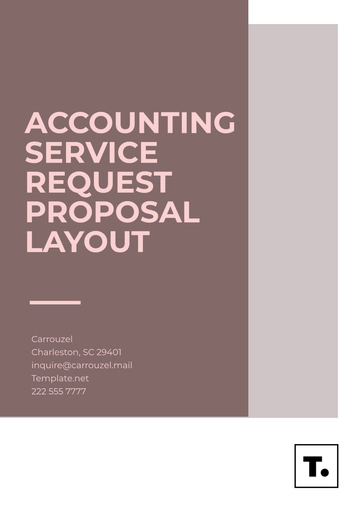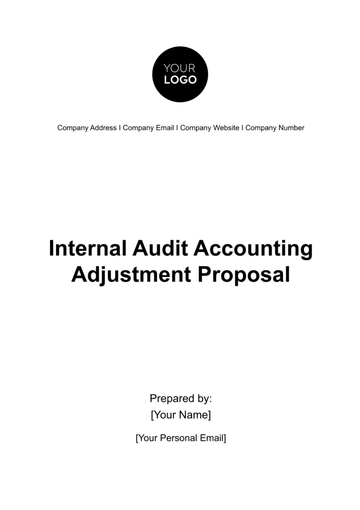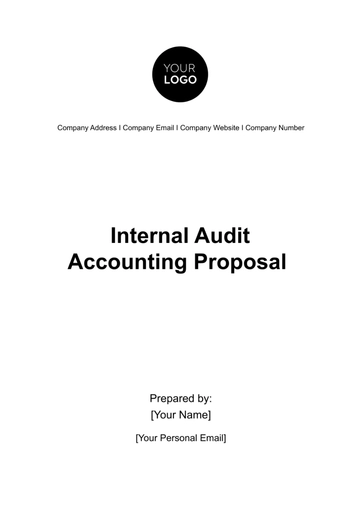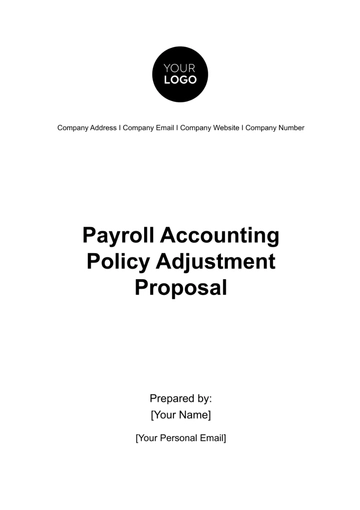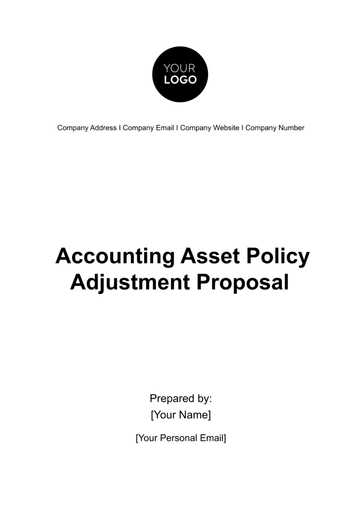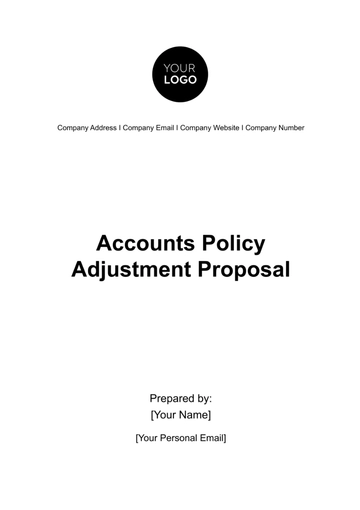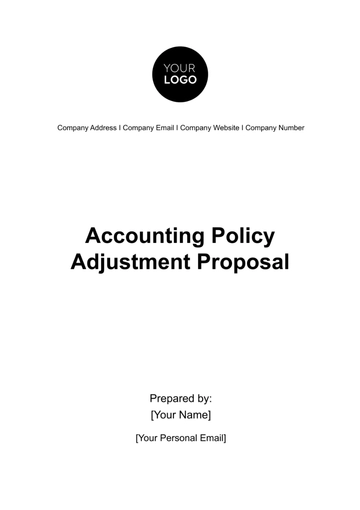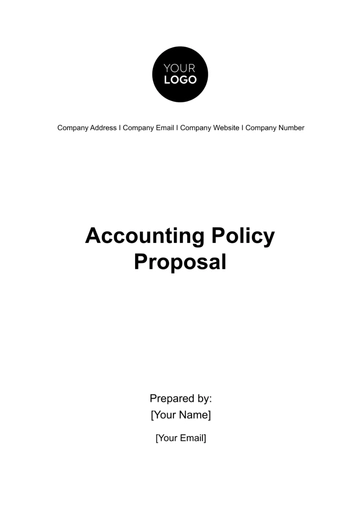Free Payroll Accounting Policy Adjustment Proposal
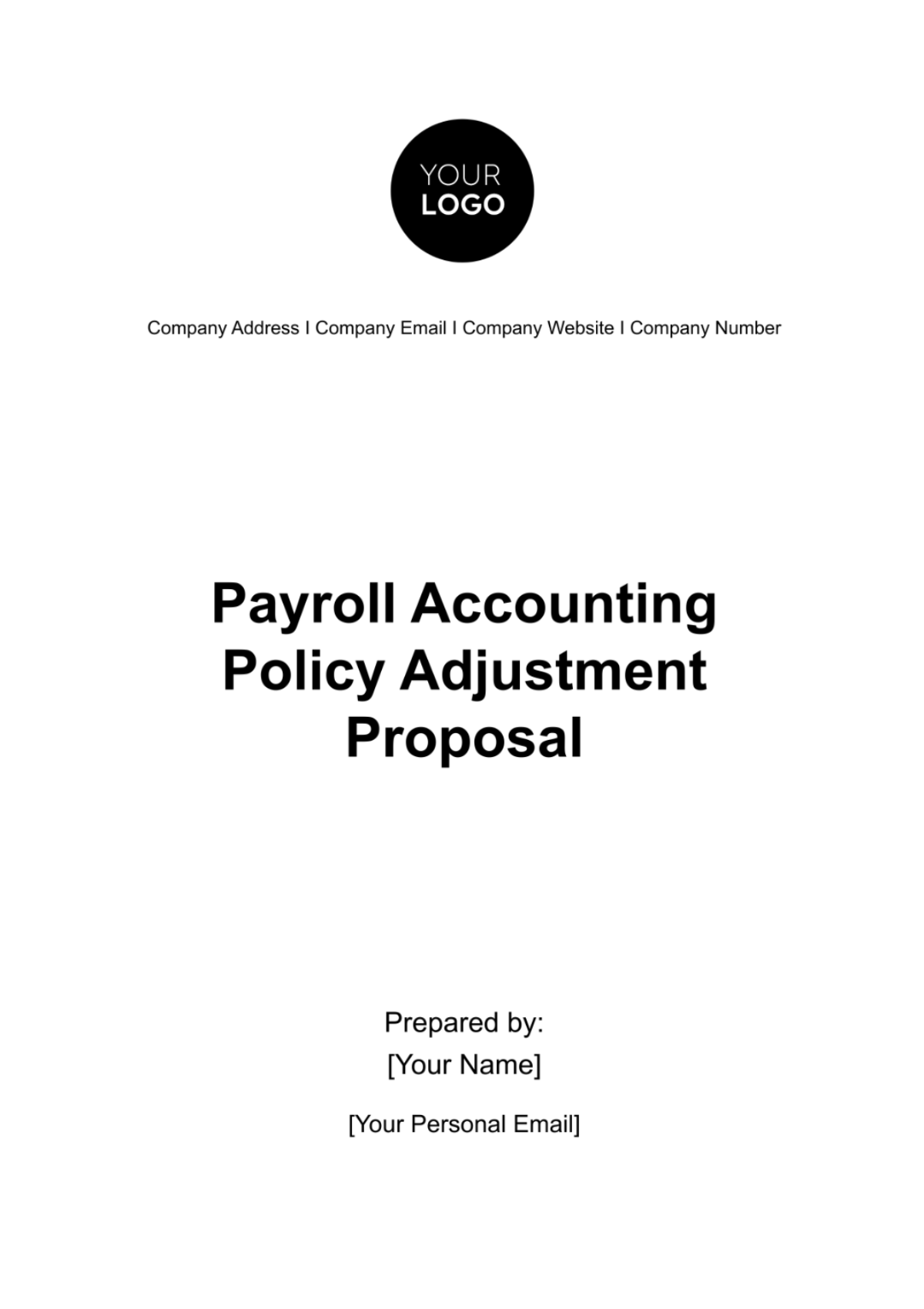
[Date]
[Recipient's Name]
[Recipient's Title]
[Company Name]
[Company Address]
[City, State, Zip]
Dear [Recipient's Name],
I am writing to present a proposal for adjustments to our payroll accounting policy, which aims to align our processes with current financial standards and optimize efficiency. This document outlines the imperative for change, driven by the evolving business landscape, and sets forth a clear, strategic path to enhance our financial operations while maintaining our commitment to transparency and compliance.
Enclosed, you will find a detailed account of our proposed objectives and the rationale behind the necessity for these adjustments. We believe that with your support, these changes will significantly contribute to our organization's operational excellence and employee satisfaction.
Thank you for considering this proposal. I look forward to discussing it with you further and am available at your convenience for any questions or clarifications.
Sincerely,
[Your Name]
[Your Title]
[Your Contact Information]
1. Executive Summary
In the face of an ever-evolving business environment, the need to adapt and refine our operational strategies is paramount. It is within this context that the necessity for adjustments to our current payroll accounting policy has emerged as a critical priority. Our comprehensive evaluation has revealed areas where enhancements can be made to not only meet the latest financial standards but also to significantly improve the efficiency and effectiveness of our payroll processes.
The proposed adjustments, detailed in this document, are designed with a dual focus: to uphold and further our commitment to financial transparency and efficiency, and to align our practices with the best industry standards. This initiative is not just about compliance; it's about taking proactive steps to ensure our payroll system is robust, responsive, and resilient, capable of supporting our organization's goals and the well-being of our workforce.
2. Objectives
The primary objectives of the proposed payroll accounting policy adjustments are fourfold:
Promote Financial Efficiency: By refining our payroll accounting practices, we aim to enhance operational efficiency, reduce unnecessary expenditures, and optimize resource allocation. Streamlining these processes will contribute to a more agile and cost-effective financial operation, directly impacting our bottom line in a positive manner.
Ensure Compliance with Industry Standards and Regulations: The regulatory landscape is continually shifting, with new standards and requirements emerging regularly. Our adjustments are designed to ensure our payroll system remains in full compliance, mitigating legal and financial risks and safeguarding our reputation in the industry.
Enhance Payroll System Effectiveness: The effectiveness of a payroll system is measured by its accuracy, timeliness, and flexibility. The proposed changes will incorporate advanced technologies and methodologies to improve these aspects, ensuring that our payroll system is not only reliable but also adaptable to changing needs.
Maximize Workforce Productivity and Satisfaction: A direct and often overlooked benefit of an efficient payroll system is its impact on employee morale and productivity. By ensuring that payroll processes are seamless, transparent, and error-free, we contribute to a positive work environment where employees feel valued and secure. This, in turn, fosters loyalty, reduces turnover rates, and enhances overall productivity.
The proposed adjustments to our payroll accounting policy are a strategic imperative aimed at reinforcing our organization's commitment to excellence in financial management, compliance, and employee satisfaction. With your support, we can implement these changes smoothly and efficiently, setting a new standard for operational excellence within our organization.
3. Methodology
The methodology for adjusting our payroll accounting policy is structured around a meticulous three-phase approach, designed to ensure comprehensive analysis, informed development, and effective implementation. Each phase is critical to achieving the desired enhancements in our payroll system.
Phase I: Evaluation and Assessment
The initial phase focuses on a thorough examination of our existing payroll accounting policies. This involves:
Data Collection: Gathering all relevant data on current payroll processes, including software used, payroll cycle frequency, compliance mechanisms, and feedback from stakeholders involved in payroll management.
Gap Analysis: Identifying discrepancies between our current practices and industry best practices, as well as any areas where we fall short of regulatory compliance.
Stakeholder Feedback: Engaging with employees from various departments, including accounting, HR, and operations, to understand their perspectives and challenges with the current payroll system.
Expert Consultation: Collaborating with external payroll and accounting experts to gain insights into potential improvements and innovations in payroll management.
This comprehensive assessment will lay the groundwork for informed and strategic development of policy adjustments.
Phase II: Development of Recommended Changes
Building on the insights gained during the assessment phase, this phase involves:
Benchmarking: Comparing our practices with those of industry leaders and competitors to identify best practices that could be adopted or adapted.
Regulatory Review: Ensuring that all recommended changes are in line with the latest legal and financial regulations, thereby future-proofing our payroll system against compliance risks.
Technology Integration: Exploring advanced payroll management technologies and software that can automate and streamline payroll processes, reduce errors, and improve efficiency.
Policy Drafting: Formulating clear, concise, and actionable policy adjustments that are easy to understand and implement, with a focus on transparency, compliance, and efficiency.
Stakeholder engagement will continue to be crucial in this phase to ensure the proposed changes are practical and meet the needs of all parts of the organization.
Phase III: Implementation and Monitoring
The final phase involves putting the developed policy adjustments into action and closely monitoring their impact:
Implementation Plan: Creating a detailed plan that outlines the steps for implementing the changes, including timelines, responsible parties, and resource allocation.
Training and Communication: Developing comprehensive training programs and communication plans to ensure that all employees are informed about the changes and trained in any new processes or systems.
Pilot Testing: Implementing the changes in a controlled environment or a specific department to test their effectiveness and make necessary adjustments before a full rollout.
Ongoing Monitoring: Establishing metrics and KPIs to continuously monitor the impact of the changes on financial efficiency, compliance, and employee satisfaction, with regular reviews and updates as needed.
This structured approach ensures that the policy adjustments are not only implemented smoothly but are also sustainable and adaptable to future changes in the business environment or regulatory landscape.
4. Scope
The scope of the proposed payroll accounting policy adjustments is strategically designed to encompass key departments within [YOUR COMPANY NAME], ensuring a seamless and integrated enhancement of our payroll systems. The adjustments aim to bring about a transformative change in how payroll operations are managed, promising a significant impact on efficiency, compliance, and employee satisfaction across the organization.
Accounting Department: As the epicenter of payroll management, the accounting department will experience the most direct changes. Adjustments will include the adoption of advanced payroll software, streamlined payroll processing methods, and updated compliance reporting protocols. These changes are aimed at reducing manual errors, improving processing times, and ensuring adherence to the latest financial regulations.
Human Resources: The human resources department will see modifications in the integration of payroll systems with employee records, benefits administration, and new hire onboarding processes. Enhanced synchronization between HR and payroll systems will ensure accurate and timely reflection of employee data, leave balances, and benefits deductions, contributing to a more transparent and trustworthy employee experience.
Operations Departments: Operations teams across the company, especially those with hourly or contingent workers, will benefit from more accurate and efficient payroll calculations, clearer communication of payroll policies, and streamlined expense reimbursement processes. This will not only improve operational efficiency but also enhance job satisfaction among employees by ensuring fair and prompt compensation for their efforts.
These adjustments will be rolled out in a phased manner, as detailed in the following timeline and budget projections, to ensure minimal disruption to ongoing operations while maximizing the effectiveness of the implementation.
5. Timeline
The timeline for the implementation of the payroll accounting policy adjustments is outlined as follows:
Phase | Start Date | End Date |
|---|---|---|
I: Evaluation | March 1, 2023 | April 1, 2023 |
II: Development | [Date] | [Date] |
III: Implementation | [Date] | [Date] |
The outlined timeline is meticulously crafted to ensure each phase of the payroll accounting policy adjustment is allocated sufficient time for thorough execution, minimizing disruptions and maximizing effectiveness.
Phase I: Evaluation (March 1, 2050 - April 1, 2050)
Week 1-2: Conduct initial meetings with department heads to outline objectives and gather existing payroll data. Deploy surveys and feedback tools to collect employee insights on current payroll satisfaction.
Week 3: Perform a detailed analysis of current payroll systems versus industry standards, identifying gaps and areas for improvement.
Week 4: Compile evaluation findings into a comprehensive report, outlining key insights and preliminary recommendations for policy adjustments.
Phase II: Development [Date]
Week 1-3: Engage with payroll software vendors for demonstrations and feasibility studies, focusing on solutions that address identified gaps.
Week 4-6: Draft detailed policy changes, incorporating technology solutions and process improvements. Initiate stakeholder review rounds for feedback and refinement.
Week 7-8: Finalize policy documentation, including implementation guidelines, training materials, and communication plans.
Phase III: Implementation [Date]
Week 1-2: Launch training sessions for all impacted departments, ensuring understanding and readiness for the new payroll policies.
Week 3-4: Begin phased rollout of policy changes, starting with pilot departments for real-world testing.
Week 5-8: Monitor implementation progress, addressing any challenges and making adjustments as necessary. Conduct final review and assessment to ensure objectives are met.
6. Budget
The budget for the payroll accounting policy adjustments is strategically designed to allocate funds effectively across all necessary activities, ensuring high-impact outcomes.
Item | Cost |
|---|---|
Systems Assessment | $10,000 |
Policy Development | $[Amount] |
Implementation & Monitoring | $[Amount |
Total | $[Amount] |
Systems Assessment ($10,000): This allocation covers the costs associated with evaluating current payroll systems, including external consultant fees, access to benchmarking data, and resources required for comprehensive internal audits.
Policy Development ($000.00): Funds designated for this segment support the creation of the new payroll policies, including the drafting of documents, stakeholder engagement activities (workshops, feedback sessions), and legal review to ensure compliance with all applicable regulations.
Implementation & Monitoring ($000.00): This portion of the budget is earmarked for the practical application of the new policies, encompassing costs related to software upgrades or new system implementations, training programs for employees, and initial monitoring tools to track the effectiveness of the changes post-implementation.
Each budget line item is carefully calculated to ensure that every phase of the project is well-supported, from initial assessment through to development, implementation, and ongoing monitoring, guaranteeing a seamless transition to more efficient and compliant payroll accounting practices.
7. Benefits, Impact, and Risk Mitigation
The proposed adjustments to the payroll accounting policy are poised to bring about substantial benefits and positive impacts across [YOUR COMPANY NAME], fundamentally transforming our approach to financial management and employee engagement. However, recognizing potential risks and planning for their mitigation is crucial to the seamless adoption and success of these changes.
Benefits:
Enhanced Financial Transparency: By refining payroll processes and adopting advanced accounting software, we will achieve greater visibility into financial transactions and payroll expenditures. This transparency not only fosters trust among stakeholders but also facilitates more informed decision-making at the management level.
Improved Employee Satisfaction: Streamlined and error-free payroll processes directly contribute to employee morale. Timely and accurate payroll processing, clear communication of benefits and deductions, and easy access to payroll information enhance the overall employee experience, leading to higher levels of job satisfaction and engagement.
Regulatory Compliance Assurance: The adjustments are designed to ensure strict adherence to the latest industry regulations and standards. By proactively aligning our policies with legal requirements, we significantly reduce the risk of financial penalties and legal challenges, safeguarding our company's reputation and financial health.
Operational Efficiency: The integration of modern payroll solutions and the optimization of related processes will eliminate inefficiencies, reduce manual labor, and decrease the likelihood of errors. This efficiency not only reduces operational costs but also allows HR and accounting teams to focus on more strategic tasks.
Data-Driven Insights: Enhanced payroll systems will provide valuable data analytics and reporting capabilities, offering insights into labor costs, departmental expenditures, and overall financial performance. These insights can inform strategy and budget planning, contributing to more effective resource allocation and financial planning.
Impact:
The ripple effects of these policy adjustments extend beyond the immediate operational improvements. By setting a new standard for payroll management, [YOUR COMPANY NAME] positions itself as a leader in financial and operational excellence. This leadership can enhance our competitive advantage, attract top talent who value transparency and efficiency, and strengthen our market position.
Risk Mitigation:
Resistance to Change: The most significant anticipated risk is the potential resistance to change from employees accustomed to existing processes. To address this, a comprehensive change management strategy will be implemented, including transparent communication about the reasons for the change, the benefits it will bring, and how it will be executed.
Education and Training: Ensuring that all affected employees receive adequate training on the new payroll system and policies is crucial. Tailored training sessions will be developed to meet the diverse needs of different departments and roles, facilitating a smooth transition.
Pilot Testing: Before a full-scale rollout, pilot testing in select departments will allow us to gather feedback, make necessary adjustments, and fine-tune our approach, reducing the risk of widespread issues post-implementation.
Continuous Support: Establishing a dedicated support team to assist employees with any challenges that arise during and after the transition will help to mitigate frustrations and address problems promptly.
8. Conclusion
The strategic adjustments proposed for our payroll accounting policy represent a forward-thinking approach to enhancing our operational framework, fostering a culture of transparency and efficiency, and upholding our commitment to regulatory compliance and employee satisfaction. These changes are meticulously designed to not only address current challenges but also to anticipate future needs, ensuring that [YOUR COMPANY NAME] remains agile and resilient in a dynamic business environment.
As we stand on the cusp of this pivotal transformation, your endorsement and active support are crucial. It is through our collective effort and shared vision that we can implement these changes effectively, ensuring a smooth transition and realizing the full spectrum of benefits. This proposal is not just a blueprint for improving payroll processes; it is a testament to our commitment to excellence, innovation, and the well-being of our workforce.
We invite you to join us in this significant endeavor, to lend your voice and expertise as we navigate this journey together. With your backing, we are confident in our ability to achieve a seamless integration of these policy adjustments, setting a new standard for operational excellence and financial integrity within our industry.
Let us embrace this opportunity to enhance our payroll accounting practices, reaffirming [YOUR COMPANY NAME]'s position as a leader committed to the highest standards of financial management and employee satisfaction. Your support in this project is not just invaluable—it is essential to our shared success and the continued growth and prosperity of our organization.
- 100% Customizable, free editor
- Access 1 Million+ Templates, photo’s & graphics
- Download or share as a template
- Click and replace photos, graphics, text, backgrounds
- Resize, crop, AI write & more
- Access advanced editor
Template.net offers the Payroll Accounting Policy Adjustment Proposal Template, a versatile document that streamlines policy updates. This editable template, compatible with our AI editor tool, simplifies the process of proposing changes to payroll policies. Craft precise proposals effortlessly, ensuring smooth transitions in your company's accounting procedures. Upgrade your payroll management with ease using Template.net's Payroll Accounting Policy Adjustment Proposal Template.
You may also like
- Business Proposal
- Research Proposal
- Proposal Request
- Project Proposal
- Grant Proposal
- Photography Proposal
- Job Proposal
- Budget Proposal
- Marketing Proposal
- Branding Proposal
- Advertising Proposal
- Sales Proposal
- Startup Proposal
- Event Proposal
- Creative Proposal
- Restaurant Proposal
- Blank Proposal
- One Page Proposal
- Proposal Report
- IT Proposal
- Non Profit Proposal
- Training Proposal
- Construction Proposal
- School Proposal
- Cleaning Proposal
- Contract Proposal
- HR Proposal
- Travel Agency Proposal
- Small Business Proposal
- Investment Proposal
- Bid Proposal
- Retail Business Proposal
- Sponsorship Proposal
- Academic Proposal
- Partnership Proposal
- Work Proposal
- Agency Proposal
- University Proposal
- Accounting Proposal
- Real Estate Proposal
- Hotel Proposal
- Product Proposal
- Advertising Agency Proposal
- Development Proposal
- Loan Proposal
- Website Proposal
- Nursing Home Proposal
- Financial Proposal
- Salon Proposal
- Freelancer Proposal
- Funding Proposal
- Work from Home Proposal
- Company Proposal
- Consulting Proposal
- Educational Proposal
- Construction Bid Proposal
- Interior Design Proposal
- New Product Proposal
- Sports Proposal
- Corporate Proposal
- Food Proposal
- Property Proposal
- Maintenance Proposal
- Purchase Proposal
- Rental Proposal
- Recruitment Proposal
- Social Media Proposal
- Travel Proposal
- Trip Proposal
- Software Proposal
- Conference Proposal
- Graphic Design Proposal
- Law Firm Proposal
- Medical Proposal
- Music Proposal
- Pricing Proposal
- SEO Proposal
- Strategy Proposal
- Technical Proposal
- Coaching Proposal
- Ecommerce Proposal
- Fundraising Proposal
- Landscaping Proposal
- Charity Proposal
- Contractor Proposal
- Exhibition Proposal
- Art Proposal
- Mobile Proposal
- Equipment Proposal
- Student Proposal
- Engineering Proposal
- Business Proposal
